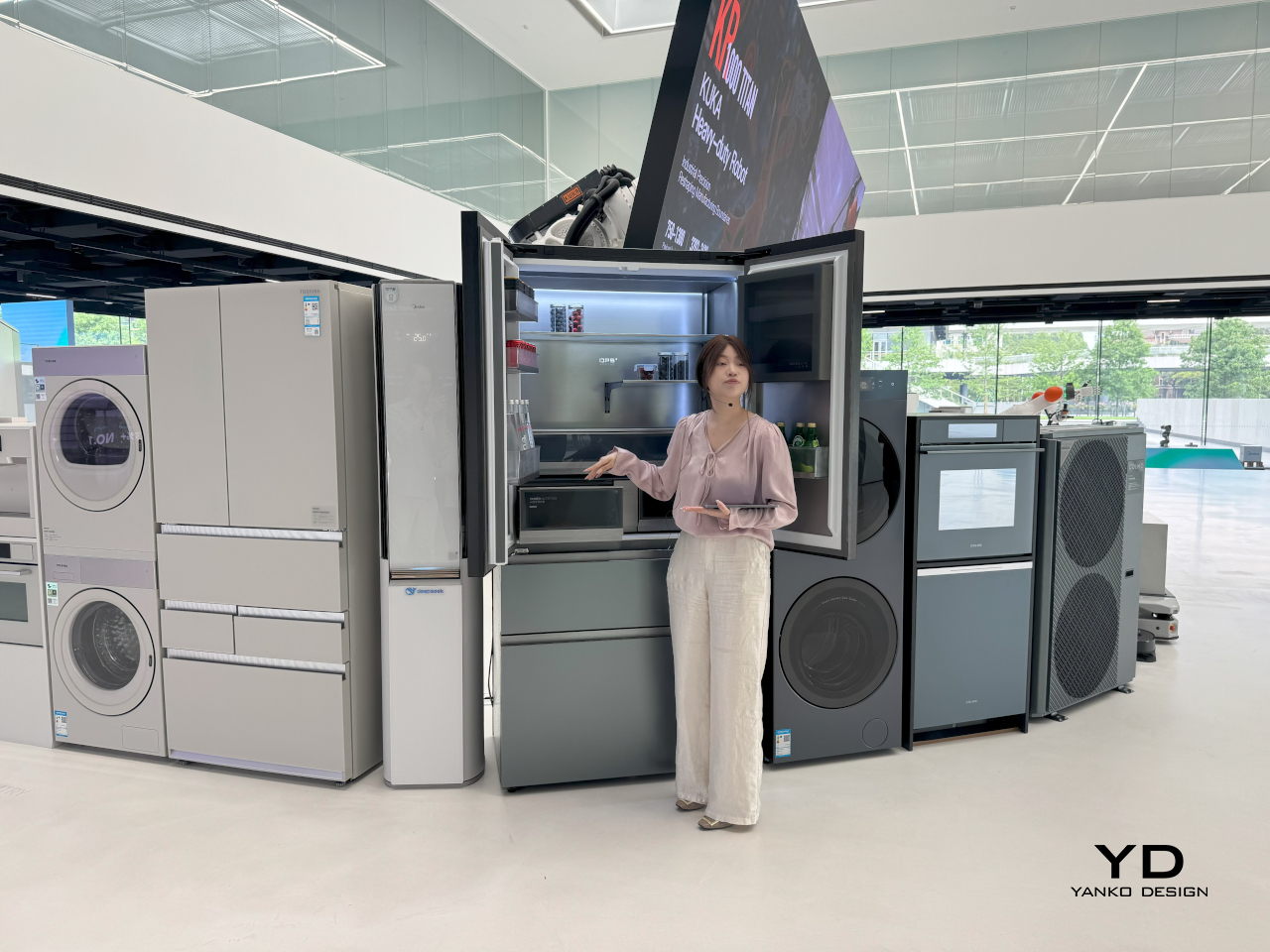When you think of global giants leading innovation in home appliances, names like LG, Samsung, or Dyson might come to mind first. But during my recent visit to Shenzhen, I realized there’s a quieter player that deserves significant attention – a company that isn’t making noise but is quietly redesigning the future of how we live: Midea.
The experience was eye-opening in many ways. As I wandered through their expansive Smart Home Showroom and learned about their Germany-based RAC Research Center, I found myself repeatedly impressed by their vision and execution. Their approach to innovation feels distinctly different from competitors who often prioritize flashy marketing over substance.
Walking through their facilities, I couldn’t help but wonder: Why aren’t more people talking about this brand that is quietly leading in so many ways? The disconnect between their global impact and public recognition struck me as both puzzling and fascinating, a story worth exploring further.
Designer: Midea
Midea: A Global Giant You May Not Know Enough About
COLMO
Founded in 1968, Midea has grown into a Fortune Global 500 company and a world leader in air conditioning systems, home appliances, and robotics. Their journey from a small workshop to a global powerhouse spanning over five decades reflects remarkable business acumen and technological vision. Currently ranked #245 on the 2022 Fortune Global 500 list, Midea continues its upward trajectory.
Yet outside of Asia and parts of Europe, its name often flies under the radar compared to louder multinational brands. This relative anonymity in some markets seems almost deliberate: a focus on substance over spectacle. As someone who has written about design innovation for years, it’s refreshing to see a company less obsessed with being “seen” and more focused on being useful.
COLMO
What struck me most during my visit was their philosophy toward product development. Midea doesn’t just design products, they design daily experiences. Their appliances anticipate needs, quietly solving problems without demanding attention. When you step back and think about it, that’s the true goal of good design: it blends into life so beautifully that it feels invisible.
From Germany to the World: The Research Powerhouse Behind Midea
Midea’s Residential Air Conditioning Research Center (RAC) in Stuttgart, Germany, was another revelation during my exploration of the company. The facility represents a significant investment in European-focused innovation, bringing together engineering talent from across the continent. Their approach to research combines German precision engineering with global market insights to create products that truly resonate with users.
Unlike many brands that retrofit global designs with minor tweaks, Midea has invested heavily in creating region-specific R&D hubs that deeply understand local needs. At RAC, the focus is sharp: precision engineering for European homes, where energy efficiency, space optimization, and climate variability are key considerations. This localized approach yields products that feel purposefully designed rather than merely adapted.
In a way, it reminded me of how thoughtful design isn’t about making one “perfect” product for everyone. It’s about caring enough to make different solutions for different lives. By marrying German engineering discipline with their scale and reach, Midea has positioned itself as a quiet leader, especially in categories like split AC systems where performance, reliability, and subtlety matter more than flashy features or marketing claims.
Innovation in Action: The Smart Home Showroom Experience
COLMO
If you ever get the chance to step into Midea’s Smart Home Showroom at their premises near Shenzhen, do it. The experience goes far beyond typical corporate displays. Not just another gimmicky setup with flashy smart gadgets, it’s a living, breathing experience of how homes can become intuitive partners in our lives. The attention to detail in creating realistic living scenarios demonstrates their deep understanding of how people actually live.
I watched lights dim automatically when someone left the room, not as a parlor trick, but as a thoughtful energy-saving feature. I saw a kitchen where the stove and chimney worked in perfect unison, adjusting air filtration dynamically based on cooking activity. The integration felt seamless rather than forced. There was even a water dispenser that could pour you a glass at your preferred temperature, no clumsy adjustments needed.
One moment that stayed with me was the children’s bedroom, fitted with motion sensors that turned off lights and AC if the child left the room. The system also monitored air quality and adjusted ventilation accordingly. Small gestures, but ones that embody what I believe true “smart living” should be about: caring for the user, quietly and gracefully. These weren’t technologies seeking attention; they were solutions addressing real needs.
Kid’s Room
The PortaSplit: Rethinking Portable Air Conditioning
PortaSplit
Among the innovations I encountered, Midea’s PortaSplit AC system was a standout. This revolutionary product merges the portability of a mobile air conditioner with the superior cooling capacity and efficiency of a split system. Think of it as the power of a split air conditioner, but made portable, without the hassle of drilling walls or mounting external units. The design elegantly solves multiple problems at once.
PortaSplit
Designed collaboratively between teams in Germany and Milan, PortaSplit brings together performance, convenience, and aesthetics in one sleek solution. The system recently received the 2023 Global Product Technical Innovation Award at IFA in Berlin, validating its groundbreaking approach. What impressed me most was how it addressed common frustrations with traditional portable units: the noise, inefficiency, and bulky appearance.
PortaSplit
It’s the kind of product that makes you realize that innovation doesn’t always mean inventing something new. Sometimes, it’s about rethinking something old in a radically better way. Flexibility is becoming more important as more people rent, move, and reshape living spaces, and a product like PortaSplit just makes sense. It’s particularly valuable for those who want efficient cooling without permanent installation or who need cooling solutions that can move with them.
Redefining Smart Living: Why Midea’s Approach Deserves More Recognition
If there’s one thing I took away from my visit, it’s this: Midea doesn’t see smart homes as a luxury or an afterthought. They see it as an essential evolution, where technology doesn’t overwhelm but supports daily life. Their approach feels human-first, not gadget-first. This philosophy permeates everything from their research centers to their product design and user interfaces.
Instead of throwing a hundred connected devices at you, they focus on systems that learn your patterns, predict your needs, and quietly adapt in the background. Their vision of connectivity serves real purposes rather than creating complexity. In a time when “smart” often gets confused with “complicated,” Midea’s philosophy feels like a breath of fresh air. It’s smart living designed to be forgotten – because when technology truly works for us, it becomes invisible.
Leaving the showroom, I couldn’t help but feel a quiet admiration for what this company has built. Their global network of 38 R&D centers and 44 major production sites reflects a serious commitment to innovation that many louder brands can’t match. Midea may not always shout the loudest, but maybe, just maybe, that’s exactly why they’re building the future better than anyone else. Sometimes the most profound innovations aren’t the ones making headlines, but the ones making life better.
The post Beyond the Surface: How Midea is Quietly Shaping the Future of Smart Living first appeared on Yanko Design.

